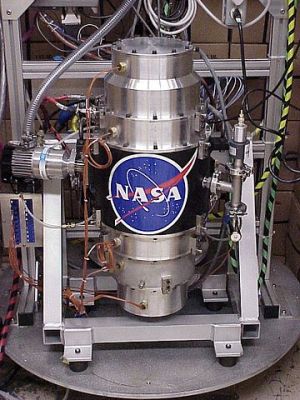Aug 14 2015
NASA's Game Changing Development (GCD) program has selected two proposals for Phase II awards targeted toward developing new energy storage technologies to replace the battery systems currently used by America's space program.
 Fly wheels, such as the NASA G2 flywheel module above, are one way to store rotational energy for use by spacecraft or machines on Earth. NASA’s looking for new energy storage systems to enable our future exploration missions. (Credits: NASA)
Fly wheels, such as the NASA G2 flywheel module above, are one way to store rotational energy for use by spacecraft or machines on Earth. NASA’s looking for new energy storage systems to enable our future exploration missions. (Credits: NASA)
Addressing several high priority challenges, NASA is making significant investments to achieve safe and affordable deep space exploration. The development of high-energy storage devices will reduce the mass required to store electrical power in space and better enable the agency's future robotic and human exploration missions.
"Technology drives exploration, and battery technology is a critical element of that drive," said Steve Jurczyk, associate administrator for the Space Technology Mission Directorate (STMD) at NASA Headquarters in Washington. "These next-generation batteries will dramatically improve the availability and affordability of the power and energy required for future exploration missions. The development effort will focus on delivering safe, low mass batteries to enable longer missions deeper into space."
The selected awardees, and their project titles, are:
- Amprius Inc. of Sunnyvale, California: Silicon Anode Based Cells for High Specific Energy Li + Systems
- University of Maryland, College Park: Garnet Electrolyte Based Safe, Lithium-Sulfur Energy Storage
NASA's technology roadmaps and strategic investment plans highlight these advanced technologies as critical to the agency's journey to Mars and future exploration. According to the National Research Council's NASA Space Technology Roadmaps and Priorities, there is a need to increase available power and eliminate the constraint of power availability for space missions.
The selected proposals will help improve energy storage with reliable power systems that can survive the wide range of NASA missions in harsh space environments, while cutting their mass by 50 percent or more.
Phase I awards were approximately $250,000, providing four awardees with the funding needed to conduct an eight-month component test and analysis phase. Phase II is an engineering hardware phase that provides as much as to $1 million per award for 12 months, and Phase III will consist of the prototype hardware development, with up to $2 million per award for 18 months.
Proposals for Phase II were received from federally funded research and development centers, universities and industry. NASA's Langley Research Center in Hampton, Virginia, manages the GCD program for STMD.
For more information about crosscutting space technology areas of interest to NASA, visit: http://www.nasa.gov/spacetech